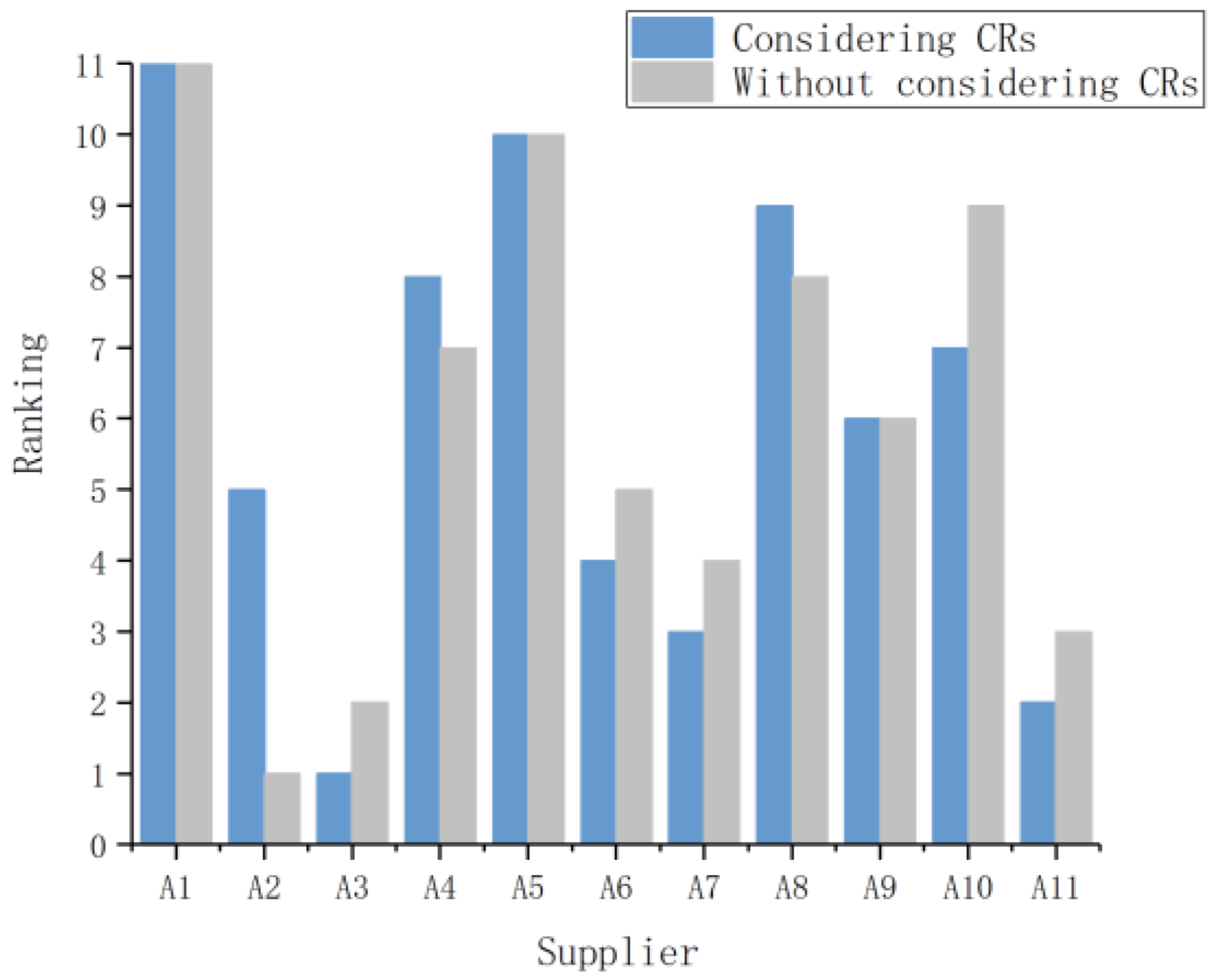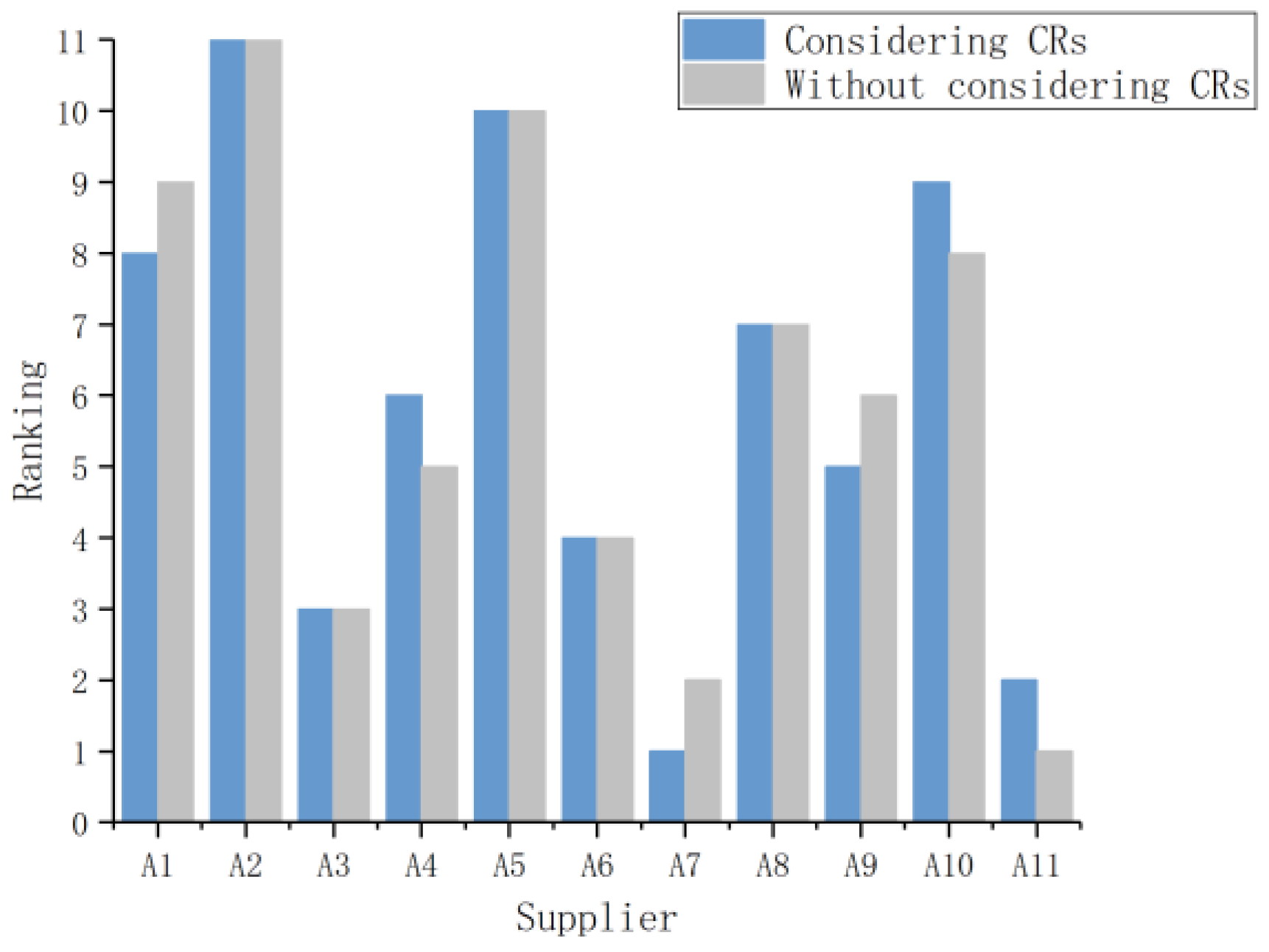To illustrate the validity and efficiency of the proposed QFD-based DNMA method with rough numbers, in this section, we make an attempt to evaluate and rank eleven alternative building-material suppliers for a reputable property developer in China. To verify the effectiveness and the robustness of the proposed model, comparative and sensitive analyses are conducted.
4.1. Case Description
The construction of whole-decoration residential products involves hundreds of building materials, such as brick, concrete, emulsion paint, integral kitchen cabinet fixture, and bathroom fixtures. In the fit-out phase, the green level, quality, and price of some functional materials vary among suppliers, and the material-supplier selection will affect the customers’ purchase intention of a whole-decoration residential product. Integral kitchen cabinet is one of the most important functional fit-out materials. On one hand, its expense accounts for a large proportion of the overall fit-out cost, and it is important in quality guarantee of a residential product; on the other hand, people use it every day for their three meals, which determines the importance of this material to home buyers. Thus, this study takes the integral-kitchen-cabinet supplier selection as an example.
Company A is one of the largest and most comprehensive property developers in China. In 2009, the property developer announced its residential whole-decoration strategy, and up to now, more than 80% of its residential products delivered to customers have been achieved in whole-decoration. To improve the green level and the quality of their delivered residential products, and reduce the cost of product fit-out through supply chain management, the management committee of the property developer conducts supplier decisions by using MAGDM methods. Eleven integral-kitchen-cabinet suppliers were selected from their supplier list for the case study.
4.2. Implementation
To investigate customer requirements and ratings of integral-kitchen-cabinet suppliers for a whole-decoration residential product, the interview survey method, combined with the questionnaire survey method, was adopted.
First, by interviewing real estate enterprises’ target customers and sales staff, we found that, for an integral kitchen cabinet of a residential product, customers are most concerned about the economic performance, the environmental certification, and the market performance. Then, 1000 questionnaires were distributed to five buildings’ sales halls, to collect the ratings of the integral-kitchen-cabinet suppliers from residential products’ visitors/buyers. The ratings should be given according to these target customers’ historical experiences, and the rating levels are divided into two: “2” for always choosing and choosing with high probability; “1” for hardly choosing and never choosing. If more than 60% of customers choose “2”, we give the supplier a rating of “2”; otherwise, a rating of “1” is given. The results are shown in
Table 2 by sorting out and analyzing the collected questionnaires.
Then, a decision-making group is invited to determine the TAs based on the material certification system, the special needs of their company, and the identified customer requirements. For example, since the company A focuses on the long-term relationship with the selected supplier, so as to deliver the residential products better, faster, and smoother, the cooperation willingness is defined as a TA. The TAs are shown in
Table 3.
The decision-making group consists of five members
: the chief executive
, the general manager
, the contract management manager
, and two experts
,
with a minimum of five years of experience managing a supply chain in a real-estate development company. The decision-making group is required to provide their individual evaluations on the 11 candidates on each TA (shown in
Table 4). After that, we use the rough number-based approach to aggregate individual DMs’ judgments, and the results are listed in
Table 5.
Next, we derive the final weights of TAs in three phases:
Phase 1 is to derive the weights of CRs. Ten customer representatives are invited to give their pairwise comparisons of the CRs (shown in
Table 6). Based on Equations (1) to (3), the rough comparison values are obtained, shown in (
Table 7). Then, the rough weights of CRs are obtained by Equations (6) to (7) as
.
Phase 2 is to establish relationships between CRs and TAs. First, we should normalize the collective rough values of the DMs (shown in
Table 8). Then, we should find a set of corresponding TA
S for each
. Since the identified CRs are independent, each
with its associated
could form an information system. In this case study, three information tables are constructed. According to DMs’ opinions,
are related to
, and
are related to
, while
are related to
. We set
and
. Here we display the calculation processes only for the second attribute
that relates to
, denoted as
.
Table 9 shows the information system that takes
as the decision condition. By Equations (9) to (11), the neighborhood relations and neighborhood information granule for supplier
on
(
) can be computed (shown in
Table 10). Next, using Equations (12) to (14), the inclusion degrees of
are obtained as
. All the results are listed in
Table 11. When
is set as 0.8, we get the lower rough sets
of
to
as
. Finally, the dependency degree of
to
is obtained as 0.55 by Equation (15). By repeating the above steps, we can acquire the objective relationships between CRs and TAs, which are presented in
Table 12.
From the yield results, we can see that customers are highly dependent on attributes , , , , and , while they pay less attention to attributes , and . In other words, customers are especially concerned about the green level, quality, and service of an integral kitchen cabinet product. Meanwhile, we can also see that, comparing with price, customers pay more attention to the product’s quality.
Phase 3 is to determine the final weights of TAs. Each weight consists of two parts: the weight of customer to
(
) and the weight given by property developers’ DMs (
) which is also called the initial relative importance of TAs. The same as CRs, we acquire the initial weights of TAs through the rough number-based pairwise comparison method. Since there are 12 TAs, according to the AHP method, a stratification is needed for weighting these attributes. In our illustrated case study, we exploit the relationships with CRs to stratify the TAs. The interlevel calculation process can be found in [
39]. By applying Equations (16) to (19), the final weights of TAs that customer voices are taken into accounts were derived, shown in
Table 13, where the parameter
is set as 0.4.
After acquiring the final weights of TAs, we then rank the suppliers by the rough set-based DNMA method. First, we normalize the aggregated rough judgments. The linear normalized values were calculated in
Table 8, while the vector normalized values can be computed by Equation (20) (shown in
Table 14). Then, Equations (21) to (24) and the comparison rules of rough numbers [
34] are employed to determine the final ranking of the alternatives with
. The results are shown in
Table 15. The comprehensive ranking of the alternatives is
, where
is supposed to be the optimal suppliers considering the voices of customers.
4.3. Comparison and Discussion
To verify the effectiveness and robustness of the proposed approach in this paper, comparative and sensitive analyses are conducted in this subsection.
We first compare the results after and before considering customer needs. The results yielded by the rough DNMA method are shown in
Figure 1, through which we find that, when customer voices are taken into accounts, supplier
is believed to be the optimal suppliers, while when evaluating these suppliers only from the perspective of the property developer, supplier
is the best one. With the in-depth analysis on
Table 2, we find that supplier
offers a good customer experience, since its integral kitchen cabinet products are always in the choice lists of customers, while that of supplier
is relatively poor, given that the supplier gains poor ratings from customers, both in the aspects of economic performance and environmental certification. From this analysis, we can see that our method effectively takes the customer voices into consideration.
In the second comparative analysis, we integrate our improved QFD method with the rough VIKOR method [
35], to verify the effectiveness of our method. The results are illustrated in
Figure 2. From this figure, we can find similar results. Supplier
is the recommend one before considering customer needs, but the supplier’s ratings by customers are poor in the aspect of market performance. Supplier
is the best choice after considering customer voices, which matches the ratings of the customer to suppliers. Therefore, customer voices were successfully considered in our proposed approach.
In the case study, we set two important parameters that relate to the neighborhood rough set as
and
. The setting of the two parameters may affect the dependency degrees of CRs to TAs. Therefore, it is necessary to verify the robustness of the model through sensitive analysis. Here, the parameter
is set as
, and
is set as
, of which the increment is 0.05. Twenty-five tests are conducted. The results yielded are shown in
Figure 3, through which we can see
is always the optimal supplier and
is always the last one. The top-five rakings generated are
,
,
,
and
. Overall, the results of the 25 tests are with small fluctuation in a normal range, which indicates the robustness of our proposed method.









